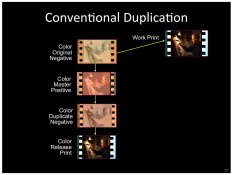Sorry for my English.
The realization of the interpositive color is economically justified when it is necessary to achieve a large number of positive copies.
If it were done directly after the negative film it would scratch, eventually it would break (hundreds of copies).
- negative color calibrated
- Copy contact the negative color calibrated on Eastman Color Intermediate
- ECN 2 development ⇒ Interpositive color
- Copy contact Color interpositive on Eastman Color Intermediate
- ECN 2 development ⇒ Internegative color
- Copy contact Internegative color on Color Print film
- ECP development ⇒ Color Print
The contrast of a color negative is 0.6.
The contrast of a intermediate film is 1.0.
The contrast of a color positive film is over 3.0.
The contrast of the final image is given by the product between the copied image and the contrast of the film used for printing.
https://www.kodak.com/US/en/motion/...niques/laboratory_aim_density_lad/default.htm
http://molly.magic.rit.edu/~mac/test/presentation_pdf.pdf Images are taken from here.
George















